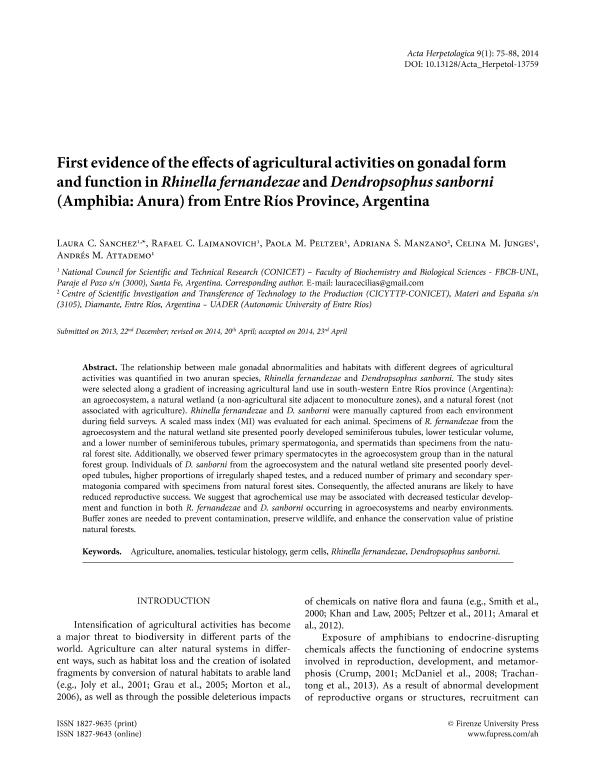Artículo
First evidence of the effects of agricultural activities on gonadal form and function in Rhinella fernandezae and Dendropsophus sanborni (Amphibia: Anura) from Entre Ríos Province, Argentina
Sanchez, Laura Cecilia ; Lajmanovich, Rafael Carlos
; Lajmanovich, Rafael Carlos ; Peltzer, Paola
; Peltzer, Paola ; Manzano, Adriana Silvina
; Manzano, Adriana Silvina ; Junges, Celina Maria
; Junges, Celina Maria ; Attademo, Andres Maximiliano
; Attademo, Andres Maximiliano
 ; Lajmanovich, Rafael Carlos
; Lajmanovich, Rafael Carlos ; Peltzer, Paola
; Peltzer, Paola ; Manzano, Adriana Silvina
; Manzano, Adriana Silvina ; Junges, Celina Maria
; Junges, Celina Maria ; Attademo, Andres Maximiliano
; Attademo, Andres Maximiliano
Fecha de publicación:
06/2014
Editorial:
Firenze University Press
Revista:
Acta Herpetologica
ISSN:
1827-9635
e-ISSN:
1827-9643
Idioma:
Inglés
Tipo de recurso:
Artículo publicado
Clasificación temática:
Resumen
The relationship between male gonadal abnormalities and habitats with different degrees of agricultural activities was quantified in two anuran species, Rhinella fernandezae and Dendropsophus sanborni. The study sites were selected along a gradient of increasing agricultural land use in south-western Entre Ríos province (Argentina): an agroecosystem, a natural wetland (a non-agricultural site adjacent to monoculture zones), and a natural forest (not associated with agriculture). Rhinella fernandezae and D. sanborni were manually captured from each environment during field surveys. A scaled mass index (MI) was evaluated for each animal. Specimens of R. fernandezae from the agroecosystem and the natural wetland site presented poorly developed seminiferous tubules, lower testicular volume,and a lower number of seminiferous tubules, primary spermatogonia, and spermatids than specimens from the natural forest site. Additionally, we observed fewer primary spermatocytes in the agroecosystem group than in the natural forest group. Individuals of D. sanborni from the agroecosystem and the natural wetland site presented poorly developed tubules, higher proportions of irregularly shaped testes, and a reduced number of primary and secondary spermatogonia compared with specimens from natural forest sites. Consequently, the affected anurans are likely to have reduced reproductive success. We suggest that agrochemical use may be associated with decreased testicular development and function in both R. fernandezae and D. sanborni occurring in agroecosystems and nearby environments.Buffer zones are needed to prevent contamination, preserve wildlife, and enhance the conservation value of pristine natural forests.
Archivos asociados
Licencia
Identificadores
Colecciones
Articulos(CCT - SANTA FE)
Articulos de CTRO.CIENTIFICO TECNOL.CONICET - SANTA FE
Articulos de CTRO.CIENTIFICO TECNOL.CONICET - SANTA FE
Articulos(CICYTTP)
Articulos de CENTRO DE INV.CIENT.Y TRANSFERENCIA TEC A LA PROD
Articulos de CENTRO DE INV.CIENT.Y TRANSFERENCIA TEC A LA PROD
Citación
Attademo, Andres Maximiliano; Junges, Celina Maria; Manzano, Adriana Silvina; Peltzer, Paola; Lajmanovich, Rafael Carlos; Sanchez, Laura Cecilia; et al.; First evidence of the effects of agricultural activities on gonadal form and function in Rhinella fernandezae and Dendropsophus sanborni (Amphibia: Anura) from Entre Ríos Province, Argentina; Firenze University Press; Acta Herpetologica; 9; 1; 6-2014; 123-136
Compartir
Altmétricas



